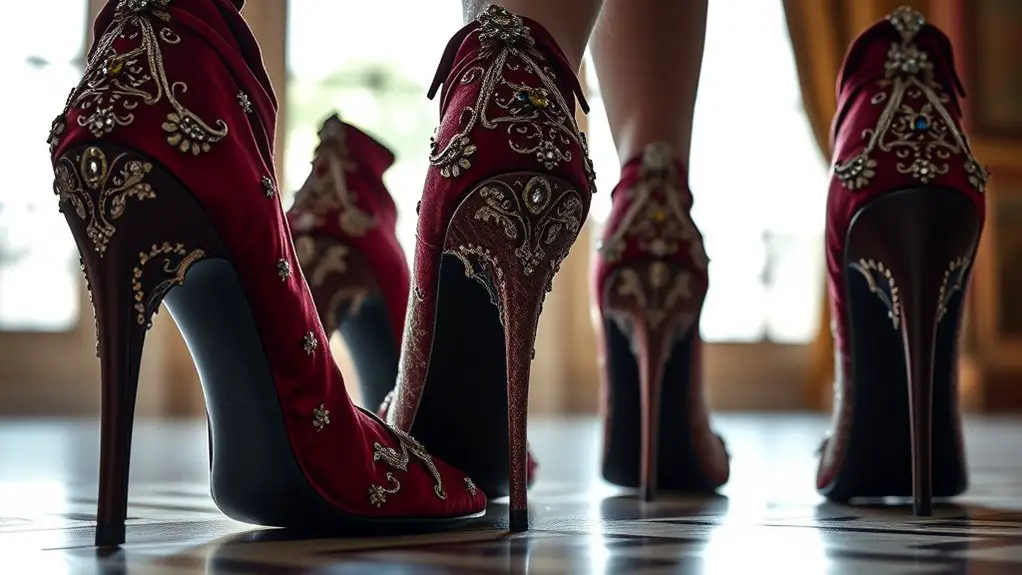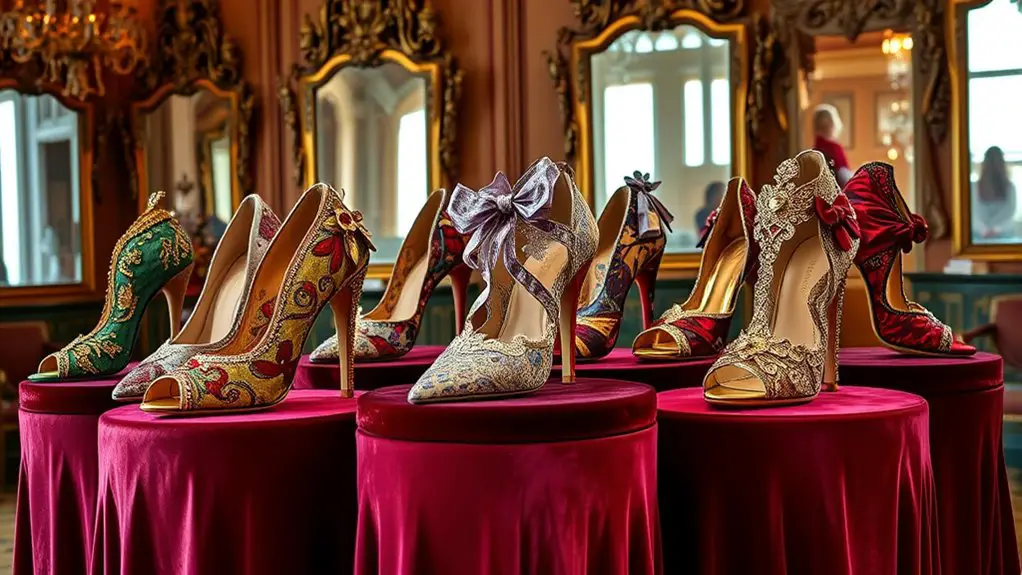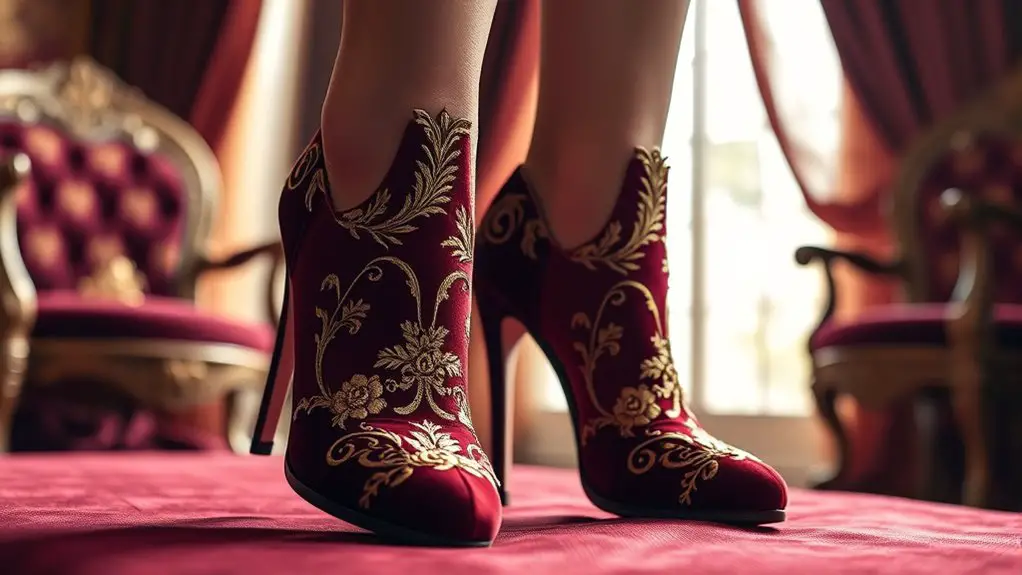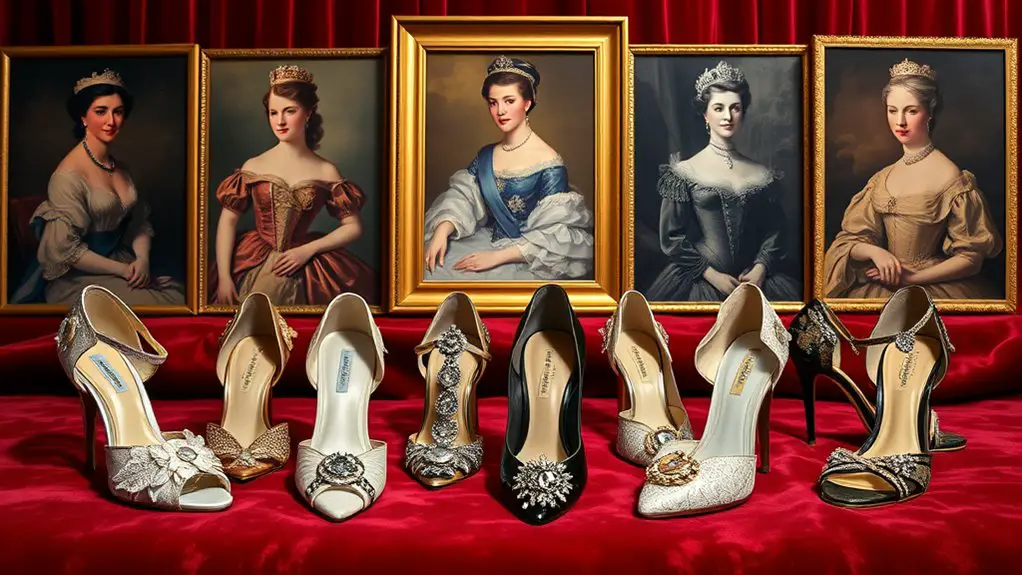High heels have evolved from practical footwear to symbols of royal stature. Initially worn by ancient warriors, their role shifted during the Renaissance, where they showcased opulence. Louis XIV’s flamboyant designs cemented high heels as a mark of power and gender distinction in 17th-century France. Victorian society continued this trend, linking heels to class privilege. Today, royals like Kate Middleton exemplify how high heels blend tradition with contemporary style, reflecting ongoing social dynamics. Explore further to uncover more fascinating details.
The Origins of High Heels: From Practicality to Prestige

Although high heels are often associated with fashion and status today, their origins reveal a fascinating evolution from practical footwear to symbols of prestige. In ancient civilizations, these elevated shoes served functional purposes, enabling warriors to gain height in the saddle, enhancing stability and comfort. As you explore deeper, you’ll discover that high heels changed from utilitarian ancient footwear into royal symbolism. They became a marker of social hierarchy, particularly in the courts of Persia and later Europe, where nobility donned them to assert power and distinction. The height of the shoe not only elevated one’s stature but also signified wealth and influence, as the materials used were often extravagant. This shift from practicality to prestige illustrates how societal values can reshape the meaning of an item, transforming it into a potent symbol of status that continues to resonate in fashion today.
High Heels in the Renaissance Court
As the Renaissance blossomed in the 15th and 16th centuries, high heels became synonymous with the opulence of royal courts, reflecting the era’s burgeoning sense of individualism and artistic expression. You’d notice how high heels were more than just a fashion statement; they embodied the Renaissance aesthetics that celebrated beauty, proportion, and refinement. Nobility wore them to elevate their stature—literally and socially—enhancing courtly elegance and signifying their status.
These shoes often featured intricate designs, showcasing craftsmanship and artistic flair, which were hallmarks of the period. The colors and materials used, such as silk and brocade, further emphasized wealth and power. In the courts of Italy and France, high heels were essential for those wanting to make a lasting impression, intertwining personal identity with the collective ideals of the time. Consequently, high heels became a critical element in the visual language of the Renaissance, encapsulating both style and significance.
The Influence of Louis XIV and the Rise of Heeled Shoes

When you consider Louis XIV’s impact on fashion, it’s clear that his flamboyant heeled shoes were more than just a trend; they symbolized his authority and the opulence of his reign. These elevated footwear choices reinforced societal hierarchies, where heel height indicated status and gender roles, reflecting the complexities of power dynamics in 17th-century France. As you explore this period, you’ll see how Louis XIV’s fashion choices not only transformed personal style but also set the stage for enduring class distinctions in footwear.
Louis XIV’s Fashion Statement
While many may associate high heels solely with modern fashion, their roots can be traced back to the extravagant reign of Louis XIV, whose passion for opulence transformed not only his wardrobe but also the very concept of footwear. He elevated heels to a status symbol, intertwining them with court etiquette and royal symbolism.
- Heels became a marker of social hierarchy.
- Brightly colored shoes indicated wealth and status.
- Louis often wore red heels, signifying his royal authority.
Symbol of Power
Louis XIV’s introduction of high heels not only shifted fashion but also redefined power dynamics within the French court and beyond. By wearing heels, he symbolized his elevated status, using royal imagery to distinguish himself from the nobility and commoners alike. The shoes became a tool of influence, allowing him to assert dominance and create a visual hierarchy. This innovation didn’t just enhance his stature; it transformed how power was perceived. As courtiers adopted this trend, the heel became synonymous with authority, shaping social interactions and expectations within the court. The allure of elevated shoes persisted, ensuring that high heels remained a potent symbol of power long after Louis XIV’s reign, influencing fashion and status across Europe.
Gender and Class Dynamics
Although heels initially served as a marker of royal authority, their adoption by various social classes transformed the dynamics of gender and class in the fashion landscape. Louis XIV’s flamboyant style popularized heeled shoes, blurring class distinction and promoting a unique form of gender representation. As heels spread from the elite to the bourgeoisie, they began to signify not just status, but also femininity and masculinity in complex ways.
- Heels became a symbol of aspiration for lower classes.
- Women utilized heels to assert their identity within patriarchal societies.
- Men, too, embraced heels, challenging traditional gender norms.
This shift in the heel’s symbolism illustrates how fashion can redefine social hierarchies and reshape perceptions of gender and class.
The Role of High Heels in Victorian Fashion

In Victorian society, high heels became a powerful symbol of social status, elevating not just stature but also one’s perceived importance. As royalty embraced these fashionable shoes, their influence trickled down to the upper and middle classes, who sought to emulate the elegance of their betters. You can see how high heels transformed from mere footwear into a statement of wealth and refinement, shaping societal norms in the process.
Victorian Social Status
High heels in Victorian fashion were more than just a style choice; they symbolized social status and class distinction. In a society governed by strict Victorian etiquette, your footwear could speak volumes about your position. High heels became essential for those engaging in social climbing, serving as a visible marker of wealth and refinement.
- They accentuated the silhouette, enhancing the perceived stature of the wearer.
- Certain styles were exclusive to the upper class, making them a badge of privilege.
- Women often paired heels with elaborate gowns, signaling their adherence to societal expectations.
In this context, high heels weren’t merely aesthetic; they were a crucial part of maneuvering the intricate social landscape of the Victorian era.
Influence of Royalty
The social dynamics of the Victorian era were profoundly shaped by the influence of royalty, particularly in matters of fashion and style. High heels became a symbol of status, largely due to royal endorsements from figures like Queen Victoria herself. When she embraced elevated footwear, it sparked fashion revolutions that rippled through society. You’d see women from all classes endeavoring to emulate the elegance of their royal counterparts, leading to a widespread adoption of high heels. These shoes weren’t just about height; they represented sophistication and social standing. The intricate designs and varying heights of heels reflected the evolving tastes of the time, making them essential in defining Victorian femininity and class distinctions. Royalty undeniably set the standard for fashion, influencing generations.
High Heels and the Suffragette Movement
As the suffragette movement gained momentum in the early 20th century, the choice of footwear became a subtle yet powerful symbol of defiance against societal norms. High heels, often seen as a symbol of femininity, were recontextualized into an act of heel activism. Women used their footwear to challenge traditional gender roles and assert their right to equality.
- Suffragette Symbolism: High heels represented the struggle for women’s rights, merging fashion with activism.
- Public Perception: Wearing heels in protests highlighted women’s determination and strength, directly confronting patriarchal expectations.
- Fashion Statements: Heels became a medium for women to express their individuality and empowerment, redefining what it meant to be a woman in society.
Through this lens, high heels served not just as a fashion choice but as a significant statement in the fight for suffrage, illustrating the intersection of style and social change.
The Glamorous Era of Hollywood and High Heels
While the silver screen dazzled audiences in the mid-20th century, it wasn’t just the performances that captivated viewers; the iconic high heels worn by Hollywood starlets became a symbol of glamour and sophistication. High heels transformed into fashion statements, defining the era’s aesthetic and influencing cultural norms.
| Celebrity | Iconic Style | Cultural Impact |
|---|---|---|
| Audrey Hepburn | Classic Pumps | Timeless Elegance |
| Marilyn Monroe | Stiletto Heels | Sensuality in Fashion |
| Elizabeth Taylor | Bold Platforms | Luxe and Opulence |
Designer collaborations flourished as starlets graced the red carpet, showcasing vintage trends that still resonate today. The celebrity influence of these actresses solidified high heels as essential to Hollywood glamour, shaping women’s fashion for generations and leaving a lasting legacy in the industry.
High Heels in Modern Royal Fashion
High heels have become a defining element of modern royal fashion, showcasing not just elegance but also a clever interplay between tradition and contemporary style. Today, royals like Kate Middleton and Meghan Markle embody this evolution, merging royal preferences with modern trends. Their choices reflect a thoughtful adaptation to societal changes, while still honoring their regal roots.
- Diverse Occasions: High heels are worn for both formal events and casual engagements, illustrating adaptability.
- Cultural Influences: Designers are now inspired by global fashion, incorporating unique elements that resonate with royal families worldwide.
- Sustainable Fashion: Many royals are now opting for eco-friendly brands, showcasing a shift towards socially responsible fashion.
This ongoing fashion evolution not only enhances the royal image but also connects them to contemporary audiences, making high heels a crucial component of their public personas.
The Impact of High Heels on Women’s Empowerment
Though often seen as a fashion accessory, high heels have played a significant role in shaping women’s empowerment throughout history. By donning these elevated shoes, women have challenged societal norms and embraced a form of feminist expression. High heels can symbolize strength and confidence, allowing you to assert your presence in spaces historically dominated by men.
When you wear heels, you’re not just making a style statement; you’re participating in a long-standing dialogue about femininity and power. The height they provide can elevate your stature, both literally and metaphorically, enabling you to navigate various social landscapes with a sense of authority.
Moreover, high heels have evolved into a canvas for personal expression, allowing you to showcase individuality against the backdrop of traditional expectations. In this way, high heels serve as both an emblem of empowerment and a means of subverting societal norms—transforming your relationship with fashion and identity.
The Future of High Heels in Fashion and Society
As the conversation around women’s empowerment continues to evolve, so too does the role of high heels in fashion and society. The future of high heels is likely to intersect with several emerging trends, shaping how you perceive and wear them.
- Emphasis on sustainable materials in high heel production.
- Rise of high heel alternatives that prioritize comfort and style.
- Increased focus on gender inclusivity and culturally sensitive designs.
Designer collaborations may push these boundaries, making high heels more accessible while addressing cultural appropriation concerns. As societal perceptions shift, you’ll find that comfort vs. style debates become more nuanced, leading to innovative designs. Digital fashion could also play a role, allowing for virtual representations of high heels that challenge traditional notions. Overall, the evolution of high heels will reflect a dynamic interplay of fashion and societal values, ensuring they remain relevant in a rapidly changing landscape.
Frequently Asked Questions
What Materials Were Traditionally Used to Make High Heels?
When you think of high heels, consider the leather craftsmanship and heel construction that define them. Traditionally, materials like fine leather, sturdy wood, and sometimes metal were used to create both elegance and durability.
How Have High Heels Influenced Male Fashion Throughout History?
High heels have shaped male fashion by introducing masculine elegance, often reflecting royal influence. Over time, their adoption by men challenged traditional norms, creating a dynamic interplay between status, style, and gender expression within society.
Are There Any Health Risks Associated With Wearing High Heels?
Yes, wearing high heels can lead to significant health implications, including foot deformities like bunions and hammertoes. Regular use might also cause joint pain and posture issues, making it essential to contemplate comfort alongside style.
What Cultural Perceptions Exist Around High Heels in Different Societies?
High heels carry varied cultural significance globally. In some societies, they symbolize femininity and status, while others view them as impractical. Understanding these societal norms helps you appreciate the diverse perceptions surrounding high heels and their impact.
How Do High Heels Affect Posture and Walking Style?
Heels heighten how you hold yourself, influencing your posture impact and altering walking dynamics. They shift your center of gravity, which can enhance elegance but may also lead to discomfort or instability if worn excessively.



